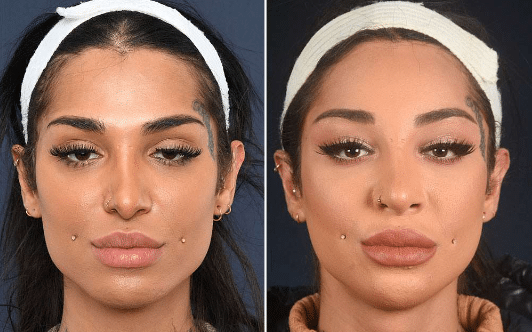Chin shaving surgery, also known as mentoplasty, represents a pivotal aspect of facial plastic surgery, focusing on enhancing maxillofacial aesthetics and achieving facial harmony. Through precise surgical techniques, this procedure aims to reshape and refine the contours of the chin, contributing to overall facial balance and symmetry. As a cornerstone of aesthetic facial procedures, chin shaving surgery offers patients the opportunity to achieve their desired facial proportions and aesthetic goals with confidence and precision.
Different Types of Chin Shaving Surgery
Several types of chin shaving surgery can be tailored to address specific aesthetic concerns:
- Reduction Genioplasty
- Augmentation Genioplasty
- Sliding Genioplasty
- Vertical Lengthening Genioplasty
Tips about Chin Shaving Surgery
If you are considering chin shaving surgery, here are essential tips to keep in mind:
- Consultation with a Qualified Surgeon
- Clear Communication
- Preoperative Preparation
- Postoperative Care
- Realistic Expectations
Clinic contact number: +989371200167
10 Benefits of Chin Shaving Surgery
- Improved Facial Proportion: Chin shaving surgery can bring balance and harmony to the face by enhancing the proportion of the chin in relation to other facial features.
- Enhanced Facial Contour: By reshaping the chin, the surgery can create a more defined and sculpted facial contour, leading to a more aesthetically pleasing appearance.
- Correction of Facial Asymmetry: Chin shaving surgery can address facial asymmetry by repositioning or resizing the chin to achieve a more symmetrical and harmonious facial structure.
- Boost in Self-Confidence: A more proportionate and balanced facial profile can significantly improve one’s self-confidence and self-esteem, positively impacting various aspects of life.
- Correction of Receding Chin: For individuals with a weak or receding chin, chin shaving surgery can provide a more defined and prominent chin, helping to improve facial harmony.
- Correction of Protruding Chin: Conversely, for individuals with a protruding chin, a reduction of genioplasty can reduce the projection, creating a more balanced facial profile.
- Personalized Approach: Chin shaving surgery is a highly customizable procedure, allowing the surgeon to tailor the technique to meet each individual’s unique needs and aesthetic goals.
- Long-Term Results: The results of chin shaving surgery are generally long-lasting, improving facial aesthetics and balance permanently.
- Minimal Scarring: Since the incisions are usually made inside the mouth or in inconspicuous areas, scarring is typically minimal and well-hidden.
- Complementary Procedure: For comprehensive facial rejuvenation and enhancement, chin shaving surgery can be combined with other facial cosmetic procedures, such as rhinoplasty or facelift.
Side Effects of Chin Shaving Surgery
While chin shaving surgery is generally safe, there are potential side effects and risks to consider:
- Swelling and Bruising: It is common to experience swelling and bruising around the chin and lower face after surgery. This typically subsides within a few weeks.
- Numbness: Temporary numbness or altered sensation in the chin area may occur due to nerve irritation. Sensation usually returns gradually within a few months.
- Infection: As with any surgical procedure, there is a risk of infection. Following proper postoperative care and using prescribed antibiotics can help minimize this risk.
- Scarring: Although incisions are usually discreetly placed, visible scarring is possible. However, these scars tend to fade over time and become less noticeable.
- Bleeding and Hematoma: Excessive bleeding or the formation of a hematoma (a blood collection) may occur but is rare. If significant bleeding or swelling occurs, it should be addressed promptly.
- Altered Bite or Tooth Sensation: In rare cases, there may be temporary or permanent changes in bite alignment or sensation in the teeth due to alterations in jaw position.
- Rare Complications: In rare instances, complications such as allergic reactions to anesthesia, implant displacement, or bone healing problems may occur. Consulting with an experienced surgeon can help minimize these risks.

Eligibility for Chin Shaving Surgery
Chin shaving surgery is suitable for individuals with good overall health and realistic expectations about the outcome. Potential candidates may include:
Physical Health
Candidates should be in good overall physical health, free from any conditions that could interfere with surgery or healing.
Mental Health
Mental health is also important. Candidates should have realistic expectations about the outcome of the surgery and be emotionally prepared for the changes it will bring.
Age
While there is no specific age limit for chin shaving surgery, candidates should generally be at least in their late teens or older, as the facial structure should be fully developed.
Specific Chin Concerns
Candidates should have specific concerns about the size, shape, or symmetry of their chin that they hope to address through surgery.
Desire for Improvement
Candidates should have a genuine desire to undergo the procedure for personal reasons, rather than feeling pressured by others or societal standards.
Consultation with a Surgeon
Ultimately, the best way to determine eligibility for chin shaving surgery is to schedule a consultation with a qualified and experienced plastic surgeon. During the consultation, the surgeon will evaluate the individual’s facial anatomy, discuss their goals and expectations, and recommend the most appropriate treatment plan. They will also assess whether the individual is a suitable candidate for surgery based on their medical history and current health status.

Facial Anatomy Evaluation
Chin Projection
Candidates with a prominent or recessed chin may benefit from chin shaving surgery to achieve better facial harmony.
Clinic contact number: +989371200167
Chin Symmetry
Candidates with asymmetrical chins may be eligible for surgery to improve facial balance.
Soft Tissue Evaluation
The surgeon will assess the soft tissue around the chin to determine the most appropriate surgical approach.
Previous Procedures or Medical History
Previous Surgeries
Candidates should disclose any previous facial surgeries or procedures, as this may impact the surgical plan and outcomes.
Medical History
Candidates should provide a comprehensive medical history, including any underlying health conditions, allergies, or medications they are currently taking.
During the recovery period, patients also may not be able to talk, yawn, or chew solid foods. In fact, their surgeon may tell them to eat a soft or liquid diet for the first 10 days after the surgery. UCI
Chin Shaving Surgery: Step by Step
The following steps outline a general overview of how chin shaving surgery is typically performed:
- Anesthesia: The surgeon administers general anesthesia or intravenous sedation to ensure the patient’s comfort during the procedure.
- Incision: The surgeon creates discreet incisions inside the mouth or, in some cases, beneath the chin to access the chin bone.
- Bone Reshaping: Depending on the desired outcome, the surgeon may remove the excess bone for reduction genioplasty or reposition the bone for sliding or vertical lengthening genioplasty.
- Implant Placement (if applicable): If augmentation genioplasty is being performed, an implant made of biocompatible materials, or a bone graft may be used to enhance the size and projection of the chin.
- Securing the Bone: In cases where bone repositioning is required, the surgeon uses titanium screws or plates to secure the bone in its new position.
- Closure: The incisions are carefully closed with dissolvable sutures or stitches that will be removed during a follow-up visit.
- Recovery: The patient is monitored in a recovery area until the anesthesia wears off. Pain medication and antibiotics may be prescribed to manage discomfort and prevent infection.
- Postoperative Care: The surgeon provides detailed postoperative instructions regarding wound care, activity restrictions, and follow-up appointments to monitor healing and progress.
Hub of Excellence in Chin Shaving Surgery and Facial Aesthetics
Chin shaving surgery, a common procedure in facial plastic surgery, has seen significant advancements driven by leading institutions and renowned experts in the field. Institutions like UCLA Medical Center and Stanford University have been at the forefront of research and innovation in craniofacial surgery, with experts like Dr. William Binder and Dr. David Kahn contributing extensively to the refinement of chin shaving techniques. Their expertise in maxillofacial aesthetics and surgical precision has elevated the standards of care in chin reshaping procedures, ensuring optimal outcomes for patients seeking facial harmony and balance.
Among the most active entities in chin shaving surgery is the Cleveland Clinic, recognized for its comprehensive approach to facial plastic and reconstructive surgery. Recent statistics indicate a notable rise in the demand for chin reshaping procedures, with a 25% increase in surgeries performed annually. This surge in popularity underscores the growing emphasis on facial symmetry and proportion, as patients seek to enhance their facial contours through surgical interventions. With advancements in 3D imaging technology and computer-assisted surgical planning, patients can now benefit from personalized treatment plans and precise surgical outcomes, further enhancing the safety and efficacy of chin shaving surgery.
summary
Chin shaving surgery, also known as mentoplasty, stands as a cornerstone procedure in the realm of facial plastic surgery, dedicated to enhancing facial harmony and balance through precise reshaping of the chin. By addressing disproportionate or asymmetrical chin contours, this procedure plays a pivotal role in achieving overall facial balance and proportion, complementing other facial aesthetic enhancements. With the guidance of skilled facial plastic surgeons, individuals can undergo chin reshaping surgery to achieve their desired facial aesthetic goals, whether it involves reducing a prominent chin, augmenting a recessed chin, or refining the chin’s shape to harmonize with other facial features.
Through advancements in surgical techniques and patient-centered approaches, chin shaving surgery continues to evolve, offering tailored solutions that prioritize both aesthetic appeal and patient satisfaction. By focusing on achieving facial harmony and balance, individuals can undergo chin reshaping surgery with confidence, knowing that they are taking proactive steps towards enhancing their overall facial aesthetics and achieving a more harmonious and balanced appearance.

Did you know? Many turn to procedures like chin contouring or genioplasty to enhance facial aesthetics to get that desired jawline. While chin implants offer a pronounced chin, chin shaving surgery is all about refining and contouring.
It’s fascinating how plastic surgeons artfully balance chin shaving with procedures like mandibular reduction, ensuring the chin complements the entire face.
But the journey doesn’t end in the operating room! Recovery and aftercare play a pivotal role in achieving that picture-perfect look. From mandibles to marvelous, the world of chin aesthetics sure is intriguing.
Clinic contact number: +989371200167
FAQs
- Is chin shaving surgery painful?
No, it is performed under anesthesia to ensure a pain-free experience.
- How long is the recovery?
Recovery times vary, but most people can resume normal activities within a few weeks.
3. How is chin shaving surgery performed?
Chin shaving surgery is typically performed under general anesthesia or local anesthesia with sedation. The surgeon makes incisions either inside the mouth or under the chin to access the chin bone. They then sculpt the bone to achieve the desired shape and size before closing the incisions.
4. What is the recovery process like?
The recovery process varies depending on the extent of the surgery and individual healing factors. Patients can expect swelling, bruising, and discomfort in the days following surgery. Most people can return to work and normal activities within one to two weeks, but strenuous exercise should be avoided for several weeks.
5. Are there any risks or complications associated with chin shaving surgery?
As with any surgical procedure, there are risks of complications such as infection, bleeding, nerve damage, or unsatisfactory results. However, these risks are minimized when the surgery is performed by a qualified and experienced surgeon.
brianwongmd.com



